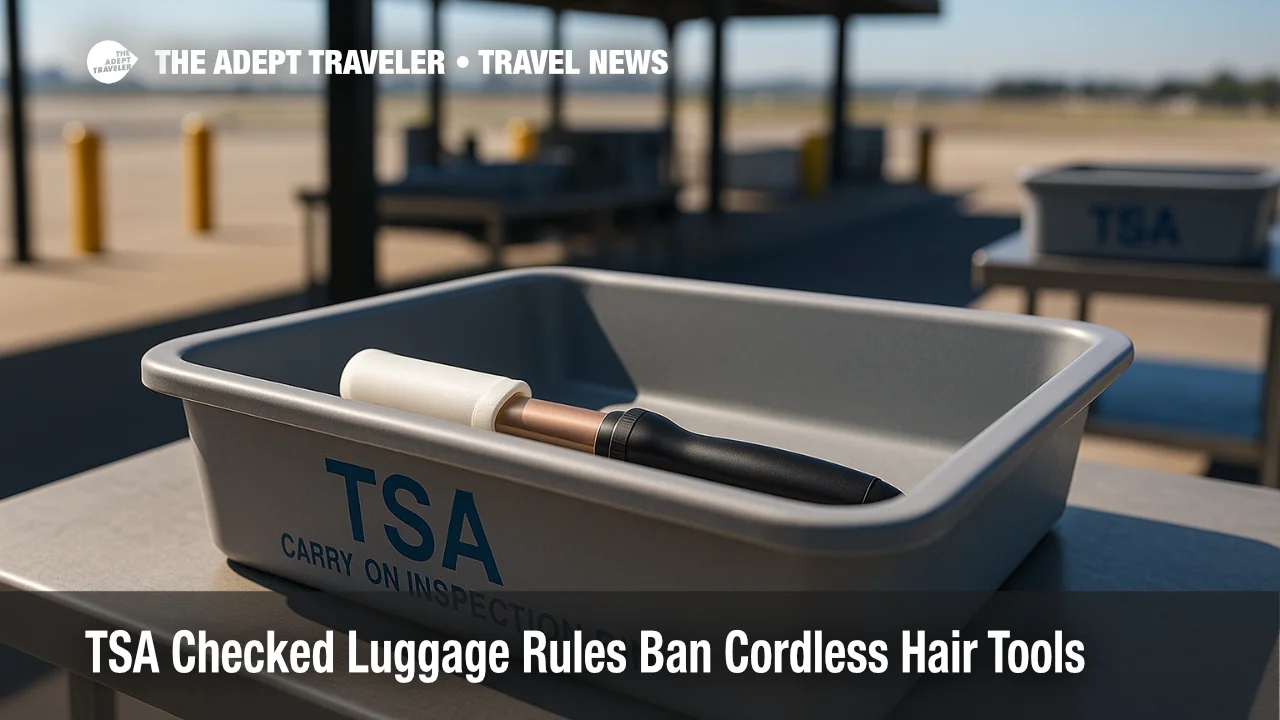TSA checked luggage rules ban cordless hair tools

The Transportation Security Administration has updated public guidance to clarify that cordless curling irons, flat irons, and hair straighteners powered by lithium ion, lithium metal, or butane are prohibited in checked luggage. These items may travel in carry-on bags only when a safety cover is secured over the heating element, and when the device is protected from accidental activation. Spare gas cartridges are banned from both checked and carry-on baggage. Plug-in hot tools remain allowed in checked and carry-on bags.
Key Points
- Why it matters: Clearer rules keep hazardous materials out of cargo holds, reducing in-flight fire risk.
- Travel impact: Cordless hair tools stay out of checked bags, and carry-ons must have safety covers.
- What's next: TSA says butane tools found in checked luggage will be removed and handed to the airline as hazmat.
- Butane refills, or spare gas cartridges, are not permitted anywhere on the aircraft.
- Corded tools that plug into a wall outlet are allowed in both checked and carry-on bags.
Snapshot
TSA's updated messaging aligns checkpoint practice with FAA hazardous materials rules for flammable gas and lithium batteries. Cordless hair tools powered by lithium cells, or fueled by butane cartridges, are now explicitly categorized as carry-on only, provided the heating element is capped and the device cannot switch on accidentally. Officers will remove any butane-powered curling irons found in checked luggage and turn them over to the airline as hazmat. Electric, wall-plugged curling irons and straighteners remain fully permitted in checked bags. The clarification follows a summer of broader security process updates, including the end of mandatory shoe removal, which we covered here, Update; TSA Ends Shoe Removal at U.S. Airport Security Checkpoints.
Background
Aircraft cargo holds are designed to contain some types of fire, but lithium battery and fuel-gas incidents can escalate quickly and require immediate access. That is why FAA rules historically restricted butane curling irons to the cabin and prohibited spare gas cartridges entirely. TSA's current guidance brings cordless hair tools into clearer focus for travelers, grouping lithium-powered straighteners and gas-fueled curling irons together as items that must stay out of checked bags. For butane models, the FAA also imposes a one-per-person limit and requires a fitted safety cover. By contrast, corded appliances have no battery or onboard fuel, so they remain allowed in both checked and carry-on luggage. The practical takeaway for travelers is simple, pack cordless hair tools in the cabin with a protective cap, never pack spare gas cartridges, and use checked bags only for plug-in devices.
Latest Developments
TSA clarifies prohibited items for checked bags, enforcement steps
TSA's item-specific pages now state that cordless hair straighteners, including those with lithium metal or lithium ion batteries and those that are gas or butane fueled, are prohibited in checked bags, and allowed only in carry-ons with a secured safety cover. The agency's page for butane curling irons reiterates that refills are not allowed anywhere on the aircraft. FAA's PackSafe guidance specifies a one-per-person limit for gas-powered curling irons and emphasizes carry-on only with a protective cap to prevent accidental activation. TSA has also signaled stricter enforcement on social media, noting that any butane curling irons discovered in checked bags will be removed and turned over to the airline as hazardous materials. Together, these updates close common loopholes, reduce confusion between battery and gas models, and give frontline officers clear, public language to support removal from checked luggage.
Analysis
The safety logic behind these changes is straightforward. Lithium batteries can enter thermal runaway, and gas cartridges can leak or vent; both scenarios are far easier to detect and manage in the cabin than in a sealed cargo hold. By codifying cordless hair tools as carry-on only, TSA removes a gray area that developed as cordless beauty devices became more common and as product descriptions blurred battery types. The requirement for a safety cover matters just as much as the carry-on restriction, because many hair tools use mechanical switches or touch sensors that can be triggered inside a bag. The prohibition on spare butane cartridges eliminates a second, often-overlooked risk.
For travelers, compliance is manageable. Bring a single butane curling iron only if it has a fitted safety cap, and never pack refills. Battery-powered straighteners belong in the cabin, stored with a protective sleeve, and kept off. If a tool uses a wall plug, it can go in checked baggage. Retailers and brands will likely need to sharpen labeling so that the power source is obvious at a glance, which should cut down on secondary screening and surrendered items. Given recent technology-driven changes at U.S. checkpoints, including the end of the shoes-off rule, consistent public guidance on prohibited items is essential to keep lines shorter while maintaining safety.
Final Thoughts
TSA's clarified rules remove guesswork and align with FAA hazmat guidance to keep risky heat sources out of the belly of the plane. Travelers should expect officers to strictly enforce carry-on only for cordless hair tools, require fitted safety covers, and seize any spare gas cartridges. If in doubt, choose a corded device for checked luggage and save cordless options for the cabin. Clear, consistent enforcement and better retail labeling will reduce surprises at the counter and shorten secondary checks, delivering the safety and speed goals behind the updated TSA checked luggage rules.
Sources
- Hair Straightener, flat iron, cordless, Transportation Security Administration
- Butane Curling Irons, cordless, Transportation Security Administration
- PackSafe, Curling Irons, cordless, Federal Aviation Administration
- TSA clarifies removal of butane curling irons found in checked bags, TSA on X
- TSA bans new item from travelers' checked luggage, SFGATE
